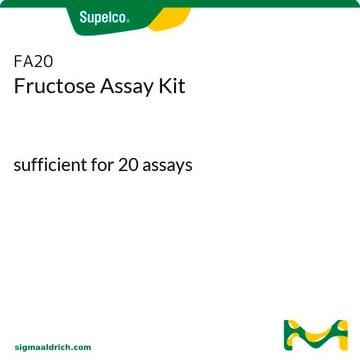G4166
Glucose Isomerase from Streptomyces murinus
≥350 U/g
Sinonimo/i:
Sweetzyme® IT Extra, D-xylose ketol-isomerase
Autenticatiper visualizzare i prezzi riservati alla tua organizzazione & contrattuali
About This Item
Numero MDL:
Codice UNSPSC:
12352204
NACRES:
NA.54
Prodotti consigliati
Origine biologica
Streptomyces sp. (S. murinus)
Forma fisica
powder
Attività specifica
≥350 U/g
Temperatura di conservazione
2-8°C
Descrizione generale
Immobilized glucose isomerase produced from a selected strain of Streptomyces murinus.
Applicazioni
Glucose Isomerase from Streptomyces murinus has been used to isomerize xylose to xylulose during the production of dihydrogen from Xylose. It has also been used in the synthetic enzymatic pathway for dihydrogen production from sucrose, to catalyze isomerization of glucose to fructose.
Immobilized glucose isomerase produced from Streptomyces murinus was used for the isomerization of xylose. Glucose isomerase is used in the food industry to produce high-fructose corn syrup.
Azioni biochim/fisiol
Few anaerobic bacteria, fungi and plants express an intracellular metalloenzyme called D-xylose isomerase (XI). Most bacteria use the enzyme D-xylose isomerase to transform D-xylose to D-xylulose. D-Xylose isomerase (XI) converts the aldo-sugars xylose and glucose to their keto analogs xylulose and fructose.
Glucose isomerase has wide variety of industrial applications such as producing high-fructose corn syrup (HFCS) and production of ethanol from hemicelluloses. In addition, it also facilitates the study of structure-function relationships by advanced biochemical and genetic engineering techniques.
Proprietà fisiche
0.33 g yields an approximate bed volume of 1ml
Definizione di unità
one unit converts glucose to fructose at an initial rate of 1 μmole per min at standard analytical conditions
Note legali
A product of Novozyme Corp.
Sweetzyme is a registered trademark of Novozymes Corp.
Codice della classe di stoccaggio
11 - Combustible Solids
Classe di pericolosità dell'acqua (WGK)
WGK 3
Punto d’infiammabilità (°F)
Not applicable
Punto d’infiammabilità (°C)
Not applicable
Dispositivi di protezione individuale
Eyeshields, Gloves, type N95 (US)
Certificati d'analisi (COA)
Cerca il Certificati d'analisi (COA) digitando il numero di lotto/batch corrispondente. I numeri di lotto o di batch sono stampati sull'etichetta dei prodotti dopo la parola ‘Lotto’ o ‘Batch’.
Possiedi già questo prodotto?
I documenti relativi ai prodotti acquistati recentemente sono disponibili nell’Archivio dei documenti.
I clienti hanno visto anche
Andrey Kovalevsky et al.
Acta crystallographica. Section D, Biological crystallography, 68(Pt 9), 1201-1206 (2012-09-06)
D-Xylose isomerase (XI) converts the aldo-sugars xylose and glucose to their keto analogs xylulose and fructose, but is strongly inhibited by the polyols xylitol and sorbitol, especially at acidic pH. In order to understand the atomic details of polyol binding
High-yield production of dihydrogen from xylose by using a synthetic enzyme cascade in a cell-free system
Martin DC, et al.
Angewandte Chemie (International Edition in English), 52(17), 4587-4590 (2013)
A D Kline et al.
Journal of molecular biology, 189(2), 377-382 (1986-05-20)
This is a preliminary report on the determination of the solution conformation of the alpha-amylase inhibitor Tendamistat by nuclear magnetic resonance and distance geometry calculations. A characterization is given of the complete polypeptide backbone fold and the side-chains of the
Philipp M Grande et al.
ChemSusChem, 5(7), 1203-1206 (2012-05-25)
Do you sea water? Water consumption will be a challenge in biorefineries, and the use of non-drinkable sources of water will be preferred. Herein, glucose is converted into 5-hydroxymethylfurfural (HMF) in a chemo-enzymatic one-pot, two-step procedure, involving immobilized glucose isomerase
Hang Zhou et al.
Metabolic engineering, 14(6), 611-622 (2012-08-28)
Xylose is the main pentose and second most abundant sugar in lignocellulosic feedstocks. To improve xylose utilization, necessary for the cost-effective bioconversion of lignocellulose, several metabolic engineering approaches have been employed in the yeast Saccharomyces cerevisiae. In this study, we
Il team dei nostri ricercatori vanta grande esperienza in tutte le aree della ricerca quali Life Science, scienza dei materiali, sintesi chimica, cromatografia, discipline analitiche, ecc..
Contatta l'Assistenza Tecnica.











